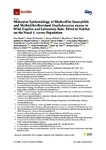Molecular Epidemiology of Methicillin-Susceptible and Methicillin-Resistant Staphylococcus aureus in Wild, Captive and Laboratory Rats: Effect of Habitat on the Nasal S. aureus Population
Raafat, Dina
Mrochen, Daniel M.
Al'Sholui, Fawaz
Heuser, Elisa
Ryll, René
Pritchett-Corning, Kathleen R.
Jacob, Jens
Walther, Bernd
Matuschka, Franz-Rainer
Richter, Dania
Westerhüs, Uta
Pikula, Jiri
van den Brandt, Jens
Nicklas, Werner
Monecke, Stefan
Strommenger, Birgit
van Alen, Sarah
Becker, Karsten
Ulrich, Rainer G.
Holtfreter, Silva
Rats are a reservoir of human- and livestock-associated methicillin-resistant Staphylococcus aureus (MRSA). However, the composition of the natural S. aureus population in wild and laboratory rats is largely unknown. Here, 144 nasal S. aureus isolates from free-living wild rats, captive wild rats and laboratory rats were genotyped and profiled for antibiotic resistances and human-specific virulence genes. The nasal S. aureus carriage rate was higher among wild rats (23.4%) than laboratory rats (12.3%). Free-living wild rats were primarily colonized with isolates of clonal complex (CC) 49 and CC130 and maintained these strains even in husbandry. Moreover, upon livestock contact, CC398 isolates were acquired. In contrast, laboratory rats were colonized with many different S. aureus lineages—many of which are commonly found in humans. Five captive wild rats were colonized with CC398-MRSA. Moreover, a single CC30-MRSA and two CC130-MRSA were detected in free-living or captive wild rats. Rat-derived S. aureus isolates rarely harbored the phage-carried immune evasion gene cluster or superantigen genes, suggesting long-term adaptation to their host. Taken together, our study revealed a natural S. aureus population in wild rats, as well as a colonization pressure on wild and laboratory rats by exposure to livestock- and human-associated S. aureus, respectively.

